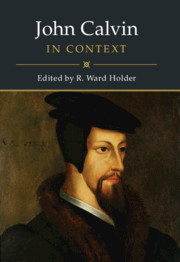Book contents
- John Calvin in Context
- John Calvin in Context
- Copyright page
- Dedication
- Contents
- Contributors
- Acknowledgments
- Abbreviations
- Introduction
- Part I France and Its Influence
- Part II Switzerland, Southern Germany, and Geneva
- Part III Empire and Society
- Part IV The Religious Question
- Part V Calvin’s Influences
- Part VI Calvin’s Reception
- 42 International Calvinism
- 43 Calvin Legends
- 44 Calvin and Calvinism in Early Modern England, Scotland, and Ireland
- 45 Calvinism in the Early Modern Netherlands and the Dutch Atlantic World
- 46 Calvin in Asia
- 47 Calvin’s Theological Legacy from the Seventeenth through the Nineteenth Centuries
- 48 The Reception of John Calvin in the Twentieth and Twenty-First Centuries
- Conclusion
- Bibliography
- Index
- References
43 - Calvin Legends
Hagiology and Demonology
from Part VI - Calvin’s Reception
Published online by Cambridge University Press: 14 November 2019
- John Calvin in Context
- John Calvin in Context
- Copyright page
- Dedication
- Contents
- Contributors
- Acknowledgments
- Abbreviations
- Introduction
- Part I France and Its Influence
- Part II Switzerland, Southern Germany, and Geneva
- Part III Empire and Society
- Part IV The Religious Question
- Part V Calvin’s Influences
- Part VI Calvin’s Reception
- 42 International Calvinism
- 43 Calvin Legends
- 44 Calvin and Calvinism in Early Modern England, Scotland, and Ireland
- 45 Calvinism in the Early Modern Netherlands and the Dutch Atlantic World
- 46 Calvin in Asia
- 47 Calvin’s Theological Legacy from the Seventeenth through the Nineteenth Centuries
- 48 The Reception of John Calvin in the Twentieth and Twenty-First Centuries
- Conclusion
- Bibliography
- Index
- References
Summary
In 1695, Andrea Pozzo was commissioned to oversee the erection of a Baroque altar at the church of the Gesù in Rome in celebration of Ignatius Loyola. French sculptor, Pierre Le Gros the younger, contributed a striking marble tableau to the project entitled, “Religion Overthrowing Heresy and Hatred.”1 With notable skill, Le Gros depicted religion as a young woman hurling firebolts at hatred and heresy represented by an old man, and the viewer is left with little question as to the identity of those levied with the grievous charge of heresy. As religion attacks heresy with a righteous anger, the figure of heresy topples backward, stepping upon a book with Martin Luther’s name written on the spine; meanwhile, the putto in the forefront of the tableau earnestly tears the writings of Ulrich Zwingli and John Calvin. The boldness of the tableau’s message and its unshakeable confidence in the Roman Catholic cause is fitting to its time; polarization between Protestants and Catholics due to post-Reformation warfare and confessionalization on the eve of the Enlightenment is surely no better illustrated.2 Calvin’s inclusion in the tableau alongside first-wave reformers, Luther and Zwingli, is something of a backhanded compliment, which speaks to his enduring perceived significance within the history of the church, acknowledged even by opponents. The tableau also illustrates how Reformation leaders, particularly, and Protestant communities, broadly, were charged in an enduring way with a litany of misdeeds including heresy as well as treason, licentiousness, and sedition. Early modern slander favored these accusations, and they functioned in an interconnected way as the unsavory inheritance of key Reformation leaders and communities including Calvin and Geneva. Indeed, it was due to these very accusations that Calvin first entered the Reformation fray as advocate on behalf of the struggling, emerging Reformed community in France.
- Type
- Chapter
- Information
- John Calvin in Context , pp. 383 - 392Publisher: Cambridge University PressPrint publication year: 2019

